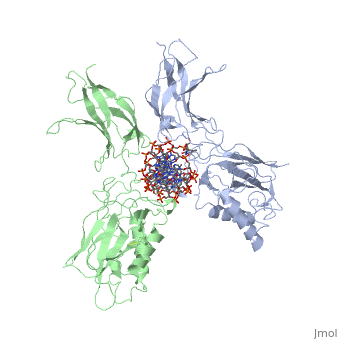1nfk
From Proteopedia
(Difference between revisions)
| Line 4: | Line 4: | ||
== Structural highlights == | == Structural highlights == | ||
<table><tr><td colspan='2'>[[1nfk]] is a 4 chain structure with sequence from [https://en.wikipedia.org/wiki/Mus_musculus Mus musculus]. Full crystallographic information is available from [http://oca.weizmann.ac.il/oca-bin/ocashort?id=1NFK OCA]. For a <b>guided tour on the structure components</b> use [https://proteopedia.org/fgij/fg.htm?mol=1NFK FirstGlance]. <br> | <table><tr><td colspan='2'>[[1nfk]] is a 4 chain structure with sequence from [https://en.wikipedia.org/wiki/Mus_musculus Mus musculus]. Full crystallographic information is available from [http://oca.weizmann.ac.il/oca-bin/ocashort?id=1NFK OCA]. For a <b>guided tour on the structure components</b> use [https://proteopedia.org/fgij/fg.htm?mol=1NFK FirstGlance]. <br> | ||
| - | </td></tr><tr id='resources'><td class="sblockLbl"><b>Resources:</b></td><td class="sblockDat"><span class='plainlinks'>[https://proteopedia.org/fgij/fg.htm?mol=1nfk FirstGlance], [http://oca.weizmann.ac.il/oca-bin/ocaids?id=1nfk OCA], [https://pdbe.org/1nfk PDBe], [https://www.rcsb.org/pdb/explore.do?structureId=1nfk RCSB], [https://www.ebi.ac.uk/pdbsum/1nfk PDBsum], [https://prosat.h-its.org/prosat/prosatexe?pdbcode=1nfk ProSAT]</span></td></tr> | + | </td></tr><tr id='method'><td class="sblockLbl"><b>[[Empirical_models|Method:]]</b></td><td class="sblockDat" id="methodDat">X-ray diffraction, [[Resolution|Resolution]] 2.3Å</td></tr> |
| + | <tr id='resources'><td class="sblockLbl"><b>Resources:</b></td><td class="sblockDat"><span class='plainlinks'>[https://proteopedia.org/fgij/fg.htm?mol=1nfk FirstGlance], [http://oca.weizmann.ac.il/oca-bin/ocaids?id=1nfk OCA], [https://pdbe.org/1nfk PDBe], [https://www.rcsb.org/pdb/explore.do?structureId=1nfk RCSB], [https://www.ebi.ac.uk/pdbsum/1nfk PDBsum], [https://prosat.h-its.org/prosat/prosatexe?pdbcode=1nfk ProSAT]</span></td></tr> | ||
</table> | </table> | ||
== Function == | == Function == | ||
| - | + | [https://www.uniprot.org/uniprot/NFKB1_MOUSE NFKB1_MOUSE] NF-kappa-B is a pleiotropic transcription factor present in almost all cell types and is the endpoint of a series of signal transduction events that are initiated by a vast array of stimuli related to many biological processes such as inflammation, immunity, differentiation, cell growth, tumorigenesis and apoptosis. NF-kappa-B is a homo- or heterodimeric complex formed by the Rel-like domain-containing proteins RELA/p65, RELB, NFKB1/p105, NFKB1/p50, REL and NFKB2/p52 and the heterodimeric p65-p50 complex appears to be most abundant one. The dimers bind at kappa-B sites in the DNA of their target genes and the individual dimers have distinct preferences for different kappa-B sites that they can bind with distinguishable affinity and specificity. Different dimer combinations act as transcriptional activators or repressors, respectively. NF-kappa-B is controlled by various mechanisms of post-translational modification and subcellular compartmentalization as well as by interactions with other cofactors or corepressors. NF-kappa-B complexes are held in the cytoplasm in an inactive state complexed with members of the NF-kappa-B inhibitor (I-kappa-B) family. In a conventional activation pathway, I-kappa-B is phosphorylated by I-kappa-B kinases (IKKs) in response to different activators, subsequently degraded thus liberating the active NF-kappa-B complex which translocates to the nucleus. NF-kappa-B heterodimeric p65-p50 and RelB-p50 complexes are transcriptional activators. The NF-kappa-B p50-p50 homodimer is a transcriptional repressor, but can act as a transcriptional activator when associated with BCL3. NFKB1 appears to have dual functions such as cytoplasmic retention of attached NF-kappa-B proteins by p105 and generation of p50 by a cotranslational processing. The proteasome-mediated process ensures the production of both p50 and p105 and preserves their independent function, although processing of NFKB1/p105 also appears to occur post-translationally. p50 binds to the kappa-B consensus sequence 5'-GGRNNYYCC-3', located in the enhancer region of genes involved in immune response and acute phase reactions. Plays a role in the regulation of apoptosis. Isoform 5, isoform 6 and isoform 7 act as inhibitors of transactivation of p50 NF-kappa-B subunit, probably by sequestering it in the cytoplasm. Isoform 3 (p98) (but not p84 or p105) acts as a transactivator of NF-kappa-B-regulated gene expression. In a complex with MAP3K8, NFKB1/p105 represses MAP3K8-induced MAPK signaling; active MAP3K8 is released by proteasome-dependent degradation of NFKB1/p105. | |
== Evolutionary Conservation == | == Evolutionary Conservation == | ||
[[Image:Consurf_key_small.gif|200px|right]] | [[Image:Consurf_key_small.gif|200px|right]] | ||
| Line 18: | Line 19: | ||
</jmol>, as determined by [http://consurfdb.tau.ac.il/ ConSurfDB]. You may read the [[Conservation%2C_Evolutionary|explanation]] of the method and the full data available from [http://bental.tau.ac.il/new_ConSurfDB/main_output.php?pdb_ID=1nfk ConSurf]. | </jmol>, as determined by [http://consurfdb.tau.ac.il/ ConSurfDB]. You may read the [[Conservation%2C_Evolutionary|explanation]] of the method and the full data available from [http://bental.tau.ac.il/new_ConSurfDB/main_output.php?pdb_ID=1nfk ConSurf]. | ||
<div style="clear:both"></div> | <div style="clear:both"></div> | ||
| - | <div style="background-color:#fffaf0;"> | ||
| - | == Publication Abstract from PubMed == | ||
| - | The 2.3-A crystal structure of the transcription factor NK-kappa B p50 homodimer bound to a palindromic kappa B site reveals that the Rel homology region folds into two distinct domains, similar to those in the immunoglobulin superfamily. The p50 dimer envelopes an undistorted B-DNA helix, making specific contacts along the 10-base-pair kappa B recognition site mainly through loops connecting secondary structure elements in both domains. The carboxy-terminal domains form a dimerization interface between beta-sheets using residues that are strongly conserved in the Rel family. | ||
| - | |||
| - | Structure of NF-kappa B p50 homodimer bound to a kappa B site.,Ghosh G, van Duyne G, Ghosh S, Sigler PB Nature. 1995 Jan 26;373(6512):303-10. PMID:7530332<ref>PMID:7530332</ref> | ||
| - | |||
| - | From MEDLINE®/PubMed®, a database of the U.S. National Library of Medicine.<br> | ||
| - | </div> | ||
| - | <div class="pdbe-citations 1nfk" style="background-color:#fffaf0;"></div> | ||
==See Also== | ==See Also== | ||
*[[NF-kB|NF-kB]] | *[[NF-kB|NF-kB]] | ||
| - | == References == | ||
| - | <references/> | ||
__TOC__ | __TOC__ | ||
</StructureSection> | </StructureSection> | ||
[[Category: Large Structures]] | [[Category: Large Structures]] | ||
[[Category: Mus musculus]] | [[Category: Mus musculus]] | ||
| - | + | [[Category: Ghosh G]] | |
| - | [[Category: Ghosh | + | [[Category: Ghosh S]] |
| - | [[Category: Ghosh | + | [[Category: Sigler PB]] |
| - | [[Category: Sigler | + | [[Category: Van Duyne G]] |
| - | [[Category: | + | |
| - | + | ||
Current revision
STRUCTURE OF THE NUCLEAR FACTOR KAPPA-B (NF-KB) P50 HOMODIMER
| |||||||||||


